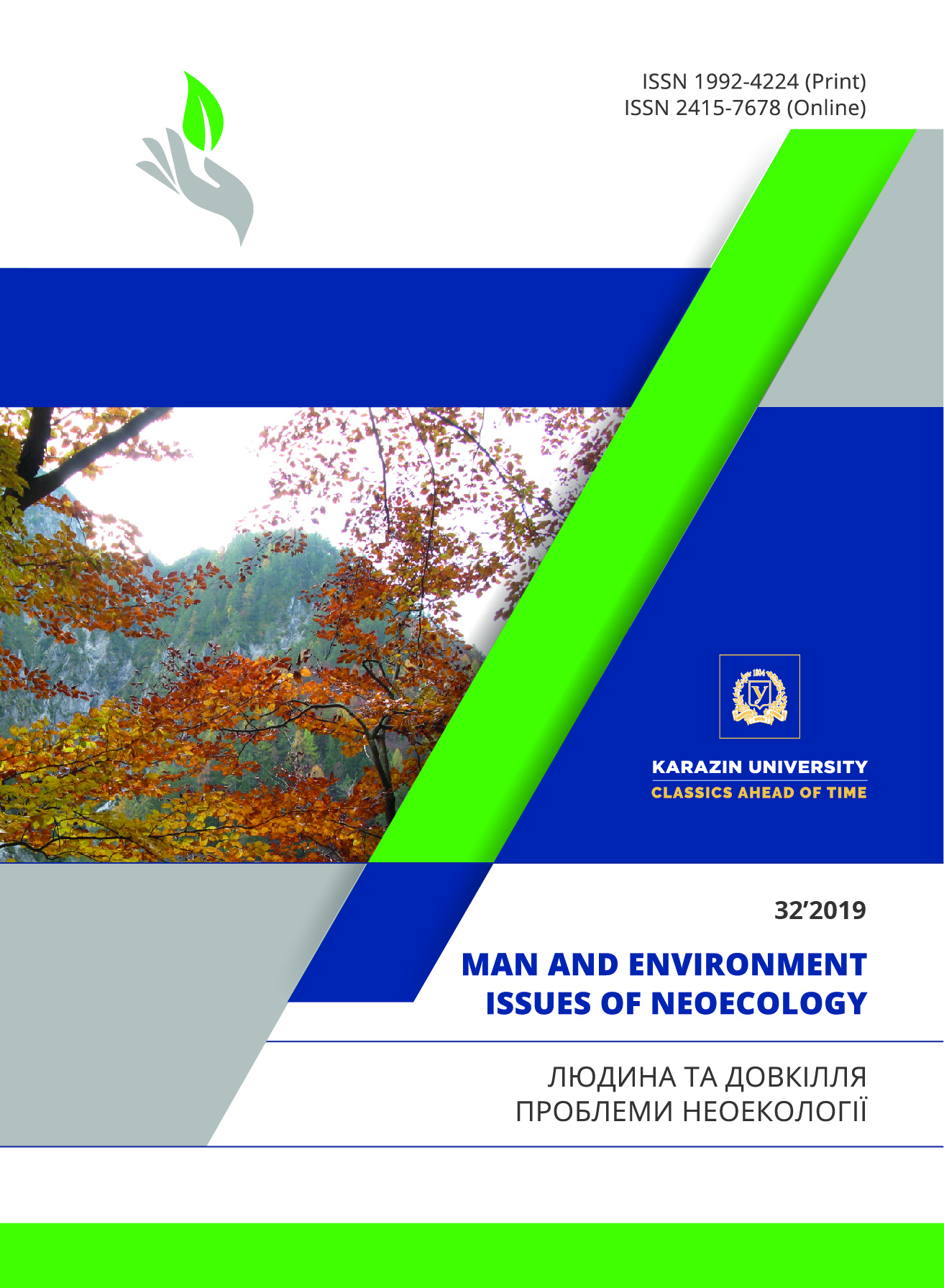Lviv Reservoirs: Current Geo-Ecological Status and Opportunities for its Improvement
Abstract
Purpose of the work is to characterize the geo-ecological condition of the reservoirs in Lviv in order to develop recommendations for the protection, conservation and enhancement of their functional use.
Methods. Field, cartographic, historical, analysis and synthesis.
Results. The geo-ecological state of modern reservoirs of Lviv has been investigated. Water pollution of represented reservoirs has been analyzed according to the fund and statistical materials. In the course of the field researches the physical parameters of the water condition have been analyzed, sources of pollution of reservoirs, clogging and overall assessment of coastal water protection strip shave been identified. Most of the reservoirs of Lviv are characterized by littering of the coastal strip, recreational impact, proximity to roads and residential buildings. The color of the water in the majority of the reservoirs is grayish-yellow, the transparency of the water is low, the smell is marsh or earthy-grassy. Ten of the twenty-three reservoirs under study have strong and over-eutrophication. In summer, some are completely overgrown with algae. The condition of the basin in 70% of Lviv reservoirs is natural. This contributes to the additional intake of pollutants from the catchment area. Ponds where the basin is covered with an artificial surface (mainly concrete) have better water quality. In particular, Levandivskyi has become the only one to have clean water at the beginning of 2019. In recent years, the water reservoirs of the city have been significantly shallow, due to the construction of catchment areas and the discharge of rainwater to the general sewer.
Conclusions. Irrational use of city reservoirs leads to water pollution, siltation and overgrowth of urban reservoirs, rapid eutrophication, clogging, etc. Reservoirs near leased restaurants and recreational facilities are in the best condition. The ponds located in park areas (Stryiskyipark, Pohulianka, Shevchenko-ethnopark, Piskovi Ozera) are in a satisfactory geo-ecological state. The most neglected are the reservoirs of former industrial enterprises, which are under control of district administrations. Taking into consideration the multifunctional importance of reservoirs for the city, recommendations have been developed to improve their geo-ecological state, mainly they are organizational (monitoring the status of reservoirs, introduction of ecological passport of the reservoir, increasing control), technical (separation of rain and municipal sewage, technical care), educational (stands, eco-actions, festivals) measures.
Downloads
References
Water Code of Ukraine from 06.06.1995 with changes from 21.09.2000, 7.12.2000, 12.12.2001. Chapter I, Chapter 1, Art. 1. (1995). Available at: https://zakon1.rada.gov.ua › laws (In Ukrainian).
Voloshyn, I., & Sobechko, O., (2013). Acid precipitation of the city of Lviv: their chemistry, metallization of natural components: monograph. Lviv, Ukraine : LDUFK. (In Ukrainian).
Voloshyn, I., Kremin, N., & Knysh, I., (2018). Limnological attractions of southwestern Lviv. Geotourism: practice and experience, 3rd International Scientific and Practical Conference 2018. Lviv, Ukraine: Kame-niar . 57-58. (In Ukrainian).
Hrytsyniak, I. I., & Kolesnyk, N. L., (2016). A significant contribution to the study of the ecological status of urban reservoirs. Fisheries Science of Ukraine 2, 132-134. (In Ukrainian).
Hural, R.I. (2012). Pollution of water biotopes of city Lviv an ditvicinitybyions of heavy metals. Scientific notes of the State Museum of Natural History, (28), 69-76. (In Ukrainian).
State Water Cadastre: A record of surface water bodies. (2018). Geoportal «Water Resources of Ukraine». (n.d.). Available at: http://map.davr.gov.ua:44481/#waterPolygonSidebar (date of appeal 02.03.2018). (In Ukrainian).
Dumych, O., Danylyk, I., &Suvadlo, I., (2019). Zooplanktofauna of the lake in park «Gorihovij Gaj». Current state and prospects of development of landscape architecture, gardening economy, urban ecology and phytomelioration, International scientific-practical conference. Lviv, Ukraine: NLTU. 228-230. (In Ukrainian).
Koinova, I., &Chorna, A-K., (2018). Lviv reservoirs: importance for the functioning of the city. Natural Re-sources of the Region: Problems of Use, Revitalization and Conservation: 3rd International Scientific Semi-nar. Lviv. 185-190. (In Ukrainian).
Koinova, I., Rozhko, I., & Chorna, A-K., (2019). Possibilities of recreational use of the reservoirs of Lviv. Ge-ography, Economics and Tourism: National and International Experience, 13th International Scientific Conference . Lviv. 273-276. (In Ukrainian).
Syrko, N., & Mykitchak, T., (2010). Fauna of plankton branched and octopus crustaceans of some reservoirs of Lviv. Scientific Basics of Biodiversity Conservation,10th Scientific Conference of Young Scientists. Lviv. 18-20. (In Ukrainian).
State of the environment in Lviv region. Information-analytical review. I quarter of 2018. (2018). deplv.gov.ua. Available at: https://drive.google.com/file/d/1513oFqctiWQcGaDWc0xtLBN1IjMJsjRS/view (In Ukrainian).
State of the environment in Lviv region. Information-analytical review. I quarter of 2019. (2019). deplv.gov.ua. Available at: https://drive.google.com/file/d/1wjQn1Hxcc44jd2Rke1MkTKSWLtbPiQhz/view (In Ukrainian).
Chorna, A-K., (2018). Pollution of the reservoirs of Lviv. Realities, problems and prospects of development of geography in Ukraine: 19th student scientific conference. Lviv: Ivan Franko Publishing Center. 130-137 (In Ukrainian).
Voloshyn, I., Vovkanych, L., & Halasa, O., (2001). Urban waters and assessment of their ecological status. Man and environment. Issues of neoecology, (2), 157-162. (In Ukrainian).
Shushniak, V., Savka, H., & Verheles, Yu., (2014). Results of the inventory of water bodies of the city of Lviv. Bulletin of the University of Lviv. The series is geographical, (48), 322-327. (In Ukrainian).
Authors reserve the right of attribution for the submitted manuscript, while transferring to the Journal the right to publish the article under the Creative Commons Attribution License 4.0 International (CC BY 4.0). This license allows free distribution of the published work under the condition of proper attribution of the original authors and the initial publication source (i.e. the Journal)
Authors have the right to enter into separate agreements for additional non-exclusive distribution of the work in the form it was published in the Journal (such as publishing the article on the institutional website or as a part of a monograph), provided the original publication in this Journal is properly referenced
The Journal allows and encourages online publication of the manuscripts (such as on personal web pages), even when such a manuscript is still under editorial consideration, since it allows for a productive scientific discussion and better citation dynamics (see The Effect of Open Access).





